|
Related FAQs: Fishes of
Hawai'i, Articles on: The Best
Butterflyfishes of Hawai'i, Triggerfishes of
Hawai'i,
Related Articles: Introduction to Fishwatcher's Guide
Series Pieces/Sections, Scott's Trip to
Maui/Hawai'i, Holualoa property,
Hawaiian Marine Biotopes,
Part 2
To: Part 1, Part 3, Part 4, Part 5, Part 6, Part 7,
|
|
|
Bob Fenner
|
|
|
Porites lobata Dana 1846, Lobe Coral.
The most common coral species in Hawai'i. Found as encrusting
colonies in high wave action areas to fifteen foot high mounds in
protected areas. Yellow to greenish in color. Often with grooves
caused by the Snapping Shrimp Alpheus deuteropus.
Below: close up of an encrusting colony, one showing shrimp space
parasite marking (both Hawai'i) and a huge colony (grow about
an inch tall per year) in the Maldives. At right, Hawaiian
specimen with pink worm parasites (Trematode, flatworm) that
Butterflyfishes pick at, consume, continuing the life cycle.
|

|
|
|
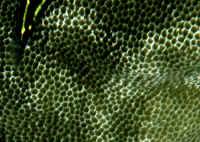
|
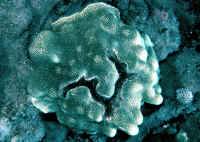
|
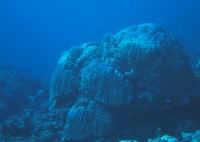
|
|
|
|
Porites rus Forsskal 1775, Plate and
Pillar Coral. Variable in shape as its common name points to.
Upright columns more shallow to gorgeous plates deeper, more calm
waters. Gray to brown in color, often with yellow polyps that
have wider spaced calyces, raised areas between polyps. Both
morphs visible here at Honaunau, City of refuge, Kailua, Kona,
Hawai'i.
|
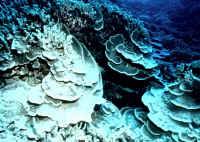
|
|
|
|
|
|
|
|
|
|
|
Family Agariciidae:
Most agariciids here are small (colonies of a few inches across) and
hidden under rock, ledges or out in the open only in deepwater.
|
Pavona varians Verrill 1864. Colonies
encrusting to laminar, showing short, irregular valleys.
Hawai'i images.
|
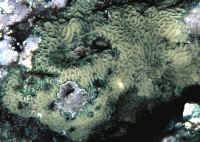
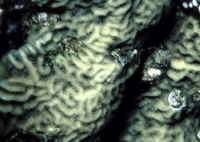
|
Family Faviidae:
|
Fungia scutaria Lamarck 1801. Oval,
heavy polyps with high, regularly placed tentacular lobes. To
seven inches. Occur in many colors. Below: Specimens in the Red
Seas upper Gulf of Aqaba, and one in the Maldives to show the
degree of arching possible.
|
|
|
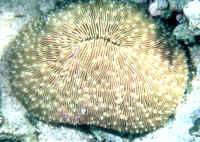
|
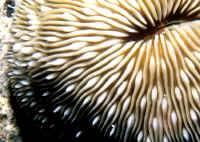
|
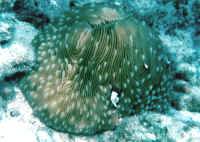
|
|
|
|
|
|
Tubastrea coccinea Lesson 1831,
Orange Cup Coral. Caribbean and Indo-Pacific. Right: Closed, open
colony pix in the Bahamas. Close up of a colony under an arch off
of Kailua Kona and exhibit images shot at the Waikiki
Aquarium.
|
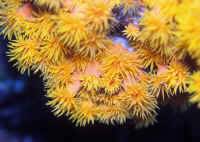
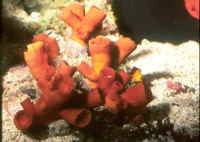
|
Worms:
|
Spirobranchus giganteus, the
Christmas Tree Worm, family Serpulidae. 1-1 1/2". Two spiral
crowned groups of radioles with a double horned operculum between
them that bears a sharp spine. Tropical West Atlantic,
Indo-Pacific. Di pix in Cozumel.
|
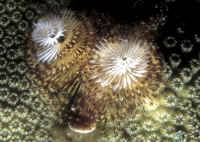
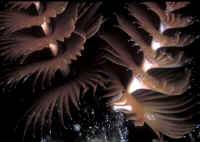
|
Mollusks:
All but a few limpets are restricted from collection in HawaiI, but
once again, there is a chance of buying conspecifics that occur
elsewhere. For instance, there are several cowry species only found
here, but some are wider spread.
|
Cypraea tigris Linnaeus 1758, the
Tiger Cowry. Too common as a "curio", this is no doubt
the best know Cowry (or at least most recognized as a sea animal
in the group). South Africa, Red Sea, Hawai'i, Society
Islands. To four inches shell length. This one off the Gilis,
Lombok, Indonesia.
|
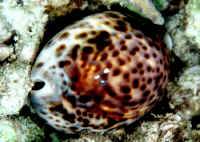
|
Crustaceans: Shrimps
If youre looking for Mantis Shrimp, HawaiI has them, as well as several
Indo-Pacific (and wider!) favorites.
|
Thor amboinensis (de Man 1888), the
Squat Anemone or Sexy Shrimp (in reference to its usually-raised
tail). 1/4-3/4" long. Common in all tropical seas. Found in
association with Giant, Sun, Elegant Anemones. Here is one in a
Condylactis gigantea in Cozumel, Mexico.
|
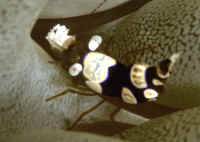
|
|
Saron marmoratus (Olivier 1811),
Marble or Saron Shrimp. Found throughout the tropical
Indo-Pacific. Usually collected out of Hawai'i for the U.S.,
the Red Sea for European markets. Usually found in pairs in the
wild. Will fight to the death if same sex individuals are placed
together. Males with much longer first pair of walking/fighting
legs. Get along fine with fishes, other crustaceans. Female
shown. Eat all types of food, reclusive, nocturnal.
|
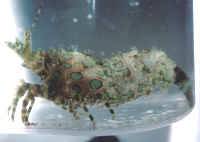
|
|
Stenopus hispidus Olivier 1811, the
Coral Banded Boxing Shrimp. Worldwide tropical distribution.
Males smaller, more slender than females. Keep in reef settings
with a cave of their own. May consume small fishes, other
crustaceans. Eat most all meaty foods.
|
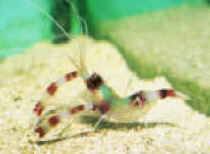
|
|
Stenopus pyrsonotus Goy & Devaney
1980, the Ghost Boxing Shrimp. Indo-Pacific, including
Hawai'i. Not as hardy as Stenopus hispidus, coming
from deeper water.
|
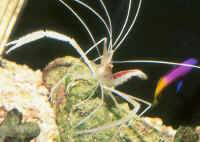
|
|
Hymenocera picta Dana 1852, the
Eastern Harlequin Shrimp. Anterior first pair of legs look like
tweezers, second pair covering them. First antennae flap-like...
waved around side to side. Live in pairs only. Noted for
their feeding exclusively on echinoderms; starfish and urchins.
Central Pacific. To about an inch and a half in length.
|
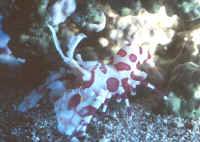
|
|
Lysmata amboinensis (De Man 1888),
the Indo-Pacific White-Striped Cleaner Shrimp or Ambon Shrimp.
Widespread in the tropical Indo-Pacific and Red Sea. Telson
white, uropods with two white dots. Can be kept singly or in
groups. A hardy Cleaner. Need hiding places to avoid predators
during molting periods. Conds: temp. 20-27 C.
|
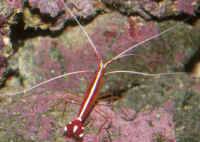
|
Reef Lobsters:
There are seven species of these small, though still destructive
astacid lobsters found in Hawaii. Enoplometopus debelius, E. holthuisi
are collected for the trade out of here as well as E. occidentalis.
|
Enoplometopus occidentalis (Randall 1840),
the Hairy or Red Reef Lobster. Found throughout the tropical
Indo-Pacific. White emarginated spots all over the body.
Nocturnal.
|
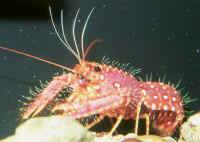
|
Echinoderms: Sea Urchins
|
Chondrocidaris gigantea A. Agassiz
1863, the Rough-Spined Urchin. Roughness of spines are generally
overgrown with bryozoans and sponges. Large animals with tests up
to 4 inches in diameter, spines to eight. Range restricted to
Hawaii (here) and New Caledonia.
|
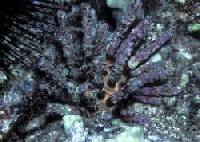
|
|
|
Echinometra mathaei (Blainville
1825), the Common Urchin. Indo-Pacific; Red Sea to Hawai'i.
To about four inches overall diameter. Hides by day in rocky
crannies it helps gouge. Mostly eats algae it rasps from rocks by
night. Here a small one in N. Sulawesi, adults in Oahu,
Hawai'i by day and Fiji at night.
|
|
|
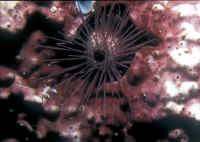
|
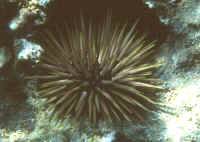
|
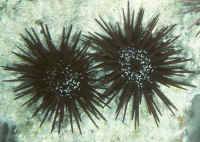
|
|
|
|
Heterocentrotus mammillatus (Linnaeus
1758), the (Red) Pencil Urchin. Indo-Pacific; Red Sea to
Hawai'i. Nocturnal, hiding in crevices by day in depths to
thirty feet, emerging at night to rasp rocks. To one foot overall
diameter. Hawai'i picture.
|
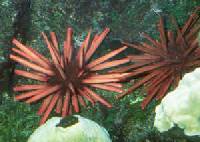
|
|
|
|
|
|
|
|
|
|
|
|
Fishes:
Moray Eels:
Hawaii is the land of the puhi (Hawaiian for eel). Nowhere else in the
world is their so many species (38) or biomass (Morays predominate the
reefs weight-wise) of morays. A couple of these are standards in the
pet-fish interest, not being overly aggressive including not eating
their fish tankmates and a small number of others imported occasionally
that are entirely piscivorous. Unless you have a very large system to
dedicate to keeping the latter, Id look into a Zebra or Snowflake
Moray.
|
Gymnomuraena zebra, the aptly named Zebra
Moray is a slow-moving chocolate black with vertical white
striped beauty. (photo). The suitability for aquaria of the
species is reflected in longevity records. Our old service
company had some in rentals for fifteen years. There are
twenty-something year citations.
|
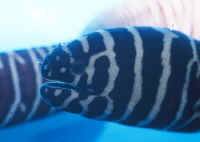
|
|
The Snowflake, Starry, or Diamond-Backed Moray, Echidna
nebulosa (Ahl 1789) is a fabulous aquarium species; small,
compatible with other fish species and adaptable to captivity. It
is certainly the most peaceful, outgoing and desirable moray
species. To about thirty inches total length. Base color of
silver gray with black and yellow "snowflakes" randomly
sprinkled over the lower body.
|
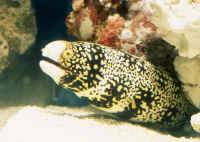
|
|
|
|
Dragon morays, Enchelychore pardalis from Hawaii are
striking with white bodies and variegated black, yellow and red
markings. Their name derives from the presence of elongate,
pointed jaws and long posterior nostril tubes. They command a
high price for their beauty and adaptability, and are worth
it. Attractive to a lesser degree, but
frequently seen in the trade, the Mediterranean Muraena
helena reaches the about half the Dragon Moray's length,
about two feet.
|
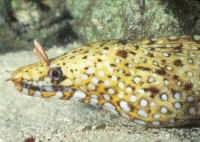
|
|
|
|
|
|
|
|
|
|
Gymnothorax pictus (Ahl 1789), the
Peppered Moray. Indo-Pacific; East Africa to the eastern Pacific,
Hawai'i. To five feet in length. This one off Kona.
|
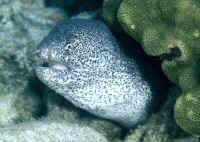
|
|
Gymnothorax undulatus (Lacepede
1803), the Undulated Moray. Indo-Pacific; East Africa to the
French Polynesia, Hawai'i. To five and a half feet in length.
This one in Hawai'i.
|
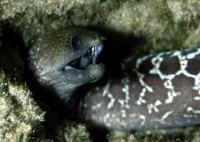
|
|
Gymnothorax meleagris (Shaw &
Nodder 1795), the White Mouth Moray. Brown to black with numerous
white spots. Dark spot around gill opening. Indo-Pacific. Most
common Hawaiian puhi/moray. To about forty inches in length.
Hawai'i image.
|
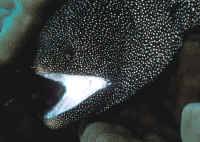
|
|
|
|
Frogfishes, Anglerfishes, Family
Antennariidae:
There are a half-dozen species of anglers found in the Hawaiian
Islands. Though none abundant, one does make its way into the hobby
sporadically, Commersons, the most common species here.
|
Antennarius commerson (Latreille
1804), the Giant or Commerson's Anglerfish. Aquarium images.
First (black) one one inch, caught in Hawai'i. Another
at the Waikiki Aquarium in O'ahu, Hawai'i, the last at
Elmer's in Pittsburgh, PA. To 13 inches in length. Widespread
in the Indo-Pacific; Red Sea to Hawai'i. Occurs in nearly all
colors, patterns (w/ the exception of blue!), modifying its
appearance within weeks to match its surroundings.
|
To: Part 1,
Part 3, Part 4, Part
5, Part 6, Part 7,
|
|

